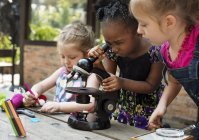Making STEM Accessible to All
Five ways a Title 1 school works to provide students with a hands-on STEM curriculum starting in preschool.
Your content has been saved!
Go to My Saved Content.STEM (science, technology, engineering, and mathematics) education plays a critical role in preparing our youth for the future and their roles in our economy. Through STEM, they engage in experiences in which they learn from and with other people, and because of that, are encouraged to think critically, innovatively, and creatively. As we continue to work to meet the demands of a technology-driven society, STEM is essential to our everyday lives as it fuels the advancement of the U.S. economy.
As an elementary school principal and champion of STEM education, I am so grateful for our hands-on, real-world-enriched curriculum at 186th Street School in Gardena, California. By exposing students to STEM and giving them opportunities to explore the field in a fun and engaging way, we help them achieve higher math and reading scores.
But there are benefits to being exposed to STEM in the classroom beyond test scores, such as improved problem-solving skills, creativity, mental alertness, and teamwork and collaboration. As leaders, we must ensure that every student has a chance to reap these benefits.
5 Ways to Encourage the Next Generation of STEM Leaders
1. Engage students in an exclusive STEM program: While there are many after-school and extracurricular programs that include STEM activities, think about in-the-classroom STEM programs that you can provide at your school.
For example, through the SAE Foundation’s “A World in Motion” program, my school partners with Toyota—the Toyota Technical Center is across the street, and engineers have come over to work with fourth-grade students to build jet toy cars. Toward the end of this program, we always hold a jet toy derby that we call “Are You Faster Than a 4th Grader?”
2. Start exposing children to STEM as early as preschool: A recent study shows that preschoolers are capable of understanding STEM concepts when presented in an age-appropriate way. My preschool and primary students participate in hands-on activities that integrate art in STEM. Through our collaboration with SAE, we help put children on this path at the earliest age possible, providing a great first impression of math and science that propels their continued interest.
We developed a Making Music pilot program that allowed our second graders to explore sound and vibrations. They got to use engineering techniques with problem-solving strategies to set goals, build their knowledge of sounds, design a toy instrument, and test and present their findings to the class.
3. Show students how STEM connects to life after school: Being able to connect what our children learn in class to the real world makes a big difference. We love bringing people in to talk about their jobs. One student’s father, an engineer with NASA’s Jet Propulsion Lab, brought in a mini Mars rover to show the students, who were so excited to learn about this amazing creation.
We also take advantage of field trips, which open our students’ eyes to new ideas, new horizons, new surroundings, and new information. Children and their parents get to see things that motivate them to strive to continue learning.
4. Tap your school network and engage with families: By engaging families and educating them about the benefits of STEM, we can help encourage and empower our students—our nation’s future leaders—to achieve more and be involved more in STEM activities.
One of my favorite things we do at my school is host School Sprit Days each month. For instance, in December, we host a family STEAM (STEM plus art) arts-and-crafts night, and in April we host a math, science, and technology night, inviting families to our computer lab for fun-filled activities.
As a Title 1 school, we have to nurture relationships and communications with our bilingual families, too. We send fliers home with information in English and Spanish, and also utilize social media to reach our parent community about our STEM programs and initiatives.
5. Utilize community resources and STEM opportunities: Take advantage of the untapped resources sitting right in front of you. Many community organizations provide financial resources and scholarship funding for many students at various grade levels. My school district holds STEAM professional development for teachers on Saturdays, inviting leaders in the community to give presentations to the teachers in order to increase their knowledge of how to create a STEAM-friendly classroom.
As we prepare our students to succeed in the 21st century, we must expose them to STEM learning. Teaching our children about STEM doesn’t have to take time out of our busy schedules. I firmly believe every child deserves a golden opportunity, and every golden opportunity deserves a child.
